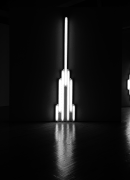
return to issue
go home
THE FORM
The shoe. The form. The body. The shoe. The foot that it belongs to. The form. The trace. The body without form. The telling. The steam. The steam surrounding shoulders. The trace. The form. The head. The legs. The hands. The body as it forks. The steam surrounding. The body as the trace. The body as the form. The missing body. The form. The form that is not there. The body.
THE STORY OF THE FORM
Mother tells the story with her body. Her arms spread wide and fork. She tells us of a person sliced in parts. She tells it all with forks. This, she says, is an ancient form I have discovered. This is the form our people left. She tells it all. The head, the guide-machine of the whole. The head inscribed with instructions for the whole. The form dictates the head be told first, she says. The instructions are told in parts. The first part tells us the head must be read first. The second I cannot decipher. The third, it has been lost. Furthermore, she says, the head must be told through the mouth. The mouth told through the eyes. The eyes told through the seething gut [this portion is an endless catalog; this portion connects all parts to parts; this portion does not end; this portion; Mother's endless voice; this . . .] It is a form that has been lost. So it remains. A trio made of four. An event-machine in whole, yet part is always missing. How, my sons, can we reconcile this formulation? How can we tell what happened, when nothing may have happened? Her body spelled in forks. The arms hang low. The hands, too. They spread among her atoms' spread. The impossibility of Mother, shrouded in steam, lifting invisibly from her shoes.
THE QUESTION OF THE STORY
Whence form? Whence nothing? Whence center? Whence gap? What has happened to us? What nothing? What head? What mouth? What fork? Where else may we exist ourselves?